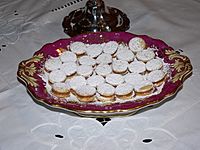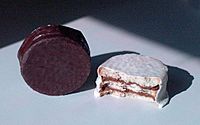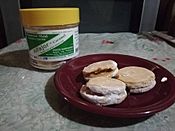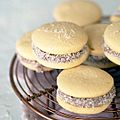Alfajor facts for kids

A typical Argentine-style alfajor
|
|
| Alternative names | Alfajores |
|---|---|
| Course | Sweet or dessert |
| Place of origin | Spain |
| Serving temperature | Room temperature |
| Main ingredients | Flour, honey, almonds, hazelnuts, dulce de leche |
An alfajor or alajú (plural alfajores) is a traditional sweet treat. You can find it in many countries, including Argentina, Bolivia, Chile, Colombia, Ecuador, Paraguay, Peru, the Philippines, Southern Brazil, Southern France, Spain, Uruguay, and Venezuela. The first alfajor came to Spain during the time of al-Andalus, a period when parts of Spain were ruled by Muslims. It is usually shaped like a small cylinder and sold alone or in boxes.
Contents
What is an Alfajor?
An alfajor is a delicious sweet that often looks like a small cylinder. In some places, especially in South America, it's made with two soft cookies joined together with a sweet filling. The most common filling is dulce de leche, which is a creamy caramel-like sauce. These cookies can be covered with powdered sugar, chocolate, or grated coconut.
Where Does the Name "Alfajor" Come From?
The word alfajor comes from the Arabic word al-fakher, which means "luxurious." This sweet treat was brought to Spain by Arabs many centuries ago. The word alfajor became part of Spanish dictionaries in the 14th century.
History of the Alfajor
The history of the alfajor goes back a long time. In 712, an Arab general named Musa ibn Nusair arrived in Spain. He brought with him many traditions, including new foods. A sweet similar to the alfajor, called alaú, is mentioned in an old Arabic cookbook from Spain.
The word alfajor was first written down in a Spanish dictionary in 1492. This shows how old and important this sweet is in Spanish culture.
How Alfajores Are Made
Traditional Spanish alfajores are made with simple, natural ingredients. These include pure honey, almonds, nuts, breadcrumbs, sugar, flour, and spices. Some common spices are aniseed, sesame, cilantro, cloves, and cinnamon.
These alfajores are usually shaped like a cylinder. They must weigh at least 30 grams and be about 7 cm long and 1.5 cm wide. Each alfajor is carefully wrapped in paper, often with a spiral design at the ends. They are then packed in wooden or cardboard boxes, never in plastic.
Alfajores in Spain

In Spain, there are many ways to make alfajores. The most traditional ones use flour, honey, almonds, and spices like cinnamon. You can find alfajores all year round in a town called Medina Sidonia. This town has been making alfajores for a very long time, and the recipe has been passed down through families.
Craftsmen in Medina Sidonia still make alfajores using old recipes. They use natural ingredients like honey, almonds, hazelnuts, sugar, flour, and breadcrumbs, mixed with natural spices. About 45,000 kilograms of alfajores are made there each year! Most of them are eaten in the Cadiz province, but they are also popular in Sevilla, Malaga, and Huelva.
In 2004, the Alfajor de Medina Sidonia received a special protection status. This means it's a unique product from that region, like how certain cheeses or wines are protected.
In another part of Spain, the province of Cuenca, the alfajor is called alajú. It's made with almonds, honey, and figs, all wrapped in a thin wafer.
Alfajores in South America
In South America, alfajores are very popular, especially in Argentina, Uruguay, and Peru. They have been a favorite snack since the mid-1800s.
South American alfajores are different from the Spanish ones. They are usually made with two round cookies that have a sweet filling in between. This filling is almost always dulce de leche, a sweet milk caramel.
Different Kinds of South American Alfajores
- Traditional: Covered with powdered sugar.
- Glazed: Covered with a sugar glaze, sometimes called "de nieve" (snow).
- Chocolate: Covered with dark or white chocolate.
- Coconut: Covered with grated coconut.
Argentina is the country where people eat the most alfajores in the world! They are a very common snack for kids and adults. Some famous brands in South America include "Jorgito," "Havanna," and "Cachafaz" from Argentina, and "Punta Ballena" from Uruguay.
Alfajores in the Caribbean
In places like Puerto Rico, alfajores have changed over time. Instead of almonds, they often use ground cassava (a root vegetable). They can have different amounts of sugar and spices. Sometimes, they are filled with chocolate, vanilla cream, fruit paste, or coconut.
Variations in the Americas

Most alfajores in Argentina, Peru, Uruguay, and Venezuela have two round cookies made from wheat flour or corn starch. They are joined with dulce de leche (also called "manjar blanco" in Peru or "arequipe" in Venezuela). They might be covered with powdered sugar, or dark or white chocolate. Some are called "alfajor de nieve" (snow alfajor) because they have a white coating made of egg whites and sugar.
In Mexico, "alfajores" are often a three-colored coconut candy. In Nicaragua, they are made with molasses and different grains like corn and cacao.
Brazil has a sweet called "bem-casado" (meaning "well wed") which is similar to an alfajor. It's also filled with doce de leite and covered with thin sugar. Another sweet, "pão de mel" (honey bread), is like a gingerbread and is often covered in dark chocolate.
Some alfajores even have a third cookie, making them an "alfajor triple"!
Guinness World Record: The Biggest Alfajor
Did you know there's a world record for the biggest alfajor? According to Guinness World Records, the largest alfajor ever made was almost two meters (about 6.5 feet) wide and 80 centimeters (about 2.6 feet) tall! It weighed 464 kilograms (over 1,000 pounds). This giant alfajor was made on December 11, 2010, in Minas, Uruguay. More than 30 people helped make it for Uruguay's first National Alfajor Festival!
Gallery
-
A jar of alfajores from the city of Baguio, Philippines
-
Havanna bakery, producer of some of the most celebrated alfajores in Argentina
Images for kids
-
Peruvian alfajor
-
A typical alfajor from Córdoba, Argentina
See also
 In Spanish: Alfajor (Latinoamérica) para niños
In Spanish: Alfajor (Latinoamérica) para niños









